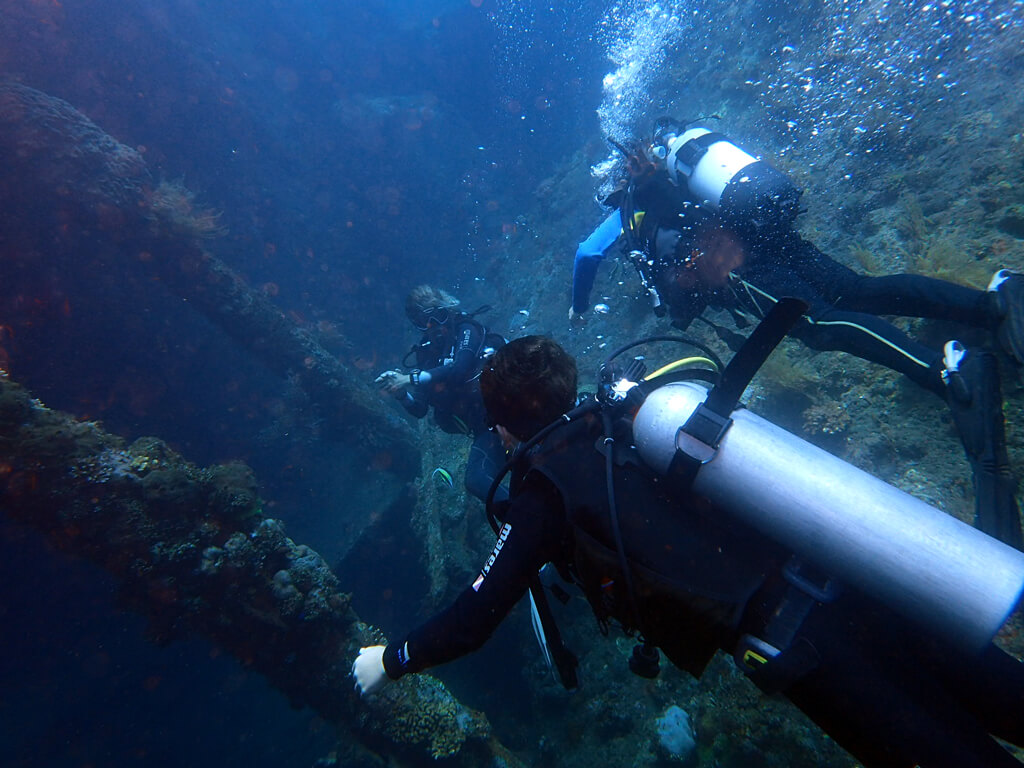Tulamben
The divesites of Tulamben
Tulamben has become Bali’s most famous diving area. Tulamben Bay, like the rest of Bali, is situated in the richest marine bio-geographic zone in the world. Being on the northeast coast, the bay receives plankton rich waters from the major ocean currents that move from the Pacific to the Indian Ocean. This, coupled with the fact that the three main dive sites provide totally different physical environments, means that Tulamben contains a stunningly diverse underwater ecosystem.
The black sand of Tulamben does not provide the reflective properties of white limestone sand and, combined with the amount of plankton in the water, accounts for the relatively low visibility. It does however provide a dramatic contrast, which brings out the colors of the corals, gorgonians, fish and other marine-life.

The USAT Liberty is Bali’s most famous dive site. Built circa WWI, this cargo ship was equipped with guns for WWII and was torpedoed by the Japanese off Lombok on the 11th of January, 1942. One US and one Dutch destroyer hitched up to the ship and tried to tow it to the port of Singaraja. The damage was immense, she was taking too much water and her crew ran the vessel up onto the beach of Tulamben, 70 km away from the nearest safe harbor. Over the years anything reusable was removed by locals. In 1963 the Liberty was pushed to her present location by the tremors of the erupting volcano Gunung Agung. During this process the hull broke into two pieces. Now she is laying only 30 meters from the Tulamben beach on a sandy slope 90 degrees on her side parallel to the shore.
The Liberty wreck dive is suitable for all levels of qualification and experience. It is the only Bali dive site that can actually become crowded as day trippers from the south brave the three hour drive for their two dives. She lies in depths from 4 to 30 meters; the shallowest part of the wreck, where it touches the sand slope, is at 4 to 10 meters. Depth along the middle of the wreck is 16 to 20 meters. The lower edge of the wreck, ie: furthest down the slope, is 20 to 28 meters (at high tide). The wreck is 120 meters long, it’s pretty broken up so no penetration is possible but you can still see the guns, toilets, boilers, anchor chain, etc. It is a lovely dive site and possibly the worlds easiest wreck dive.
The wreck is now completely covered in healthy coral growth, and the numerous structural holes provide endless opportunities for exploration. Soft corals dominate here, with crinoids, feather stars and hydroids. Fish life here is simply awesome with marine biologists estimating that about 400 different species of reef fish live on the Liberty alone. Most of the medium sized fish have become tame and will literally swarm divers in the shallows. Night diving the wreck especially on a full moon is an amazing experience where Spanish dancers and flashlight fish can be seen among the swirling phosphorescence.
Tulamben Wall drops off to over 60 meters and is located around 500 meters to the east of the world famous USAT Liberty Wreck. Topography consists of three coral carpeted lava spurs that plumet down to 50 meters or so with an overhang at around 18 meters. There is a magnificent purple gorgonian sea fan at about 28 meters that is over 2 meters in diameter. there are big bumphead parrotfish to be seen here and the black sand plays home to ornate ghost pipefish and comet fish. The area also seems to attract a lot of lionfish for some unknown reason
This area lies between the Liberty Wreck and the Drop Off. It is called Coral Garden or simply House Reef. The shallow slopes here drop to a maximum depth of 25 meters and are home to all manner of macro delights. Marine life is extremely diverse and you will see ribbon eels, octopus, anemone-fish, harlequin shrimp, morays, many juvenile species and often Black Tip sharks. Also a great night dive venue where Spanish dancers alongside boxer and hairy crabs can be found.
A 15 minute boat ride from Tulamben bay will take you to these two off shore rocky outcrops, topography is quite dramatic with three steep ridges covered in hard coral. The sand is no longer volcanic, the water is cooler and even the fish life is different to back in the bay. Visibility is often better here and larger predators come in to feed including sharks and barracuda. Hammerheads and Mantas have been spotted at this dive site.
Tulamben diving:
- Diver experience level: All level (also excellent for snorkeling)
- Start time: 8.30 – 15.00; A scenic one hour drive from our dive center
- Dive site access: Shore
- Marine conditions: wreck, photography, macro, deep
- Current: no current to moderate
- Depth: 6m- 40m
- Temperature: 26-30 degrees
About the day :
- We collect you from your hotel around 08.00
- Depart dive center around 8.30
- Arrive in Tulamben around 9.30
(before the other dive centers from South Bali arrive) - 1st dive (morning)
- Lunch at the beachfront restaurant
(with shower facilities) - 2nd dive (afternoon)
- Return to dive center around 15.00
Price & Inclusions
Price for 2 Dives – US$ 95
Inclusions:
Hotel transfers (Candidasa Area), lunch, water & snack, use of towel, tanks, weights & guide.
(Outside Candidasa area pickup / drop available for surcharge)
Equipment rental:
US$ 20 / person for a full set: BCD, regulator, wetsuit, fins/boots, mask/snorkel
Additional Dive Computer / Torch US$ 7.50 per day

